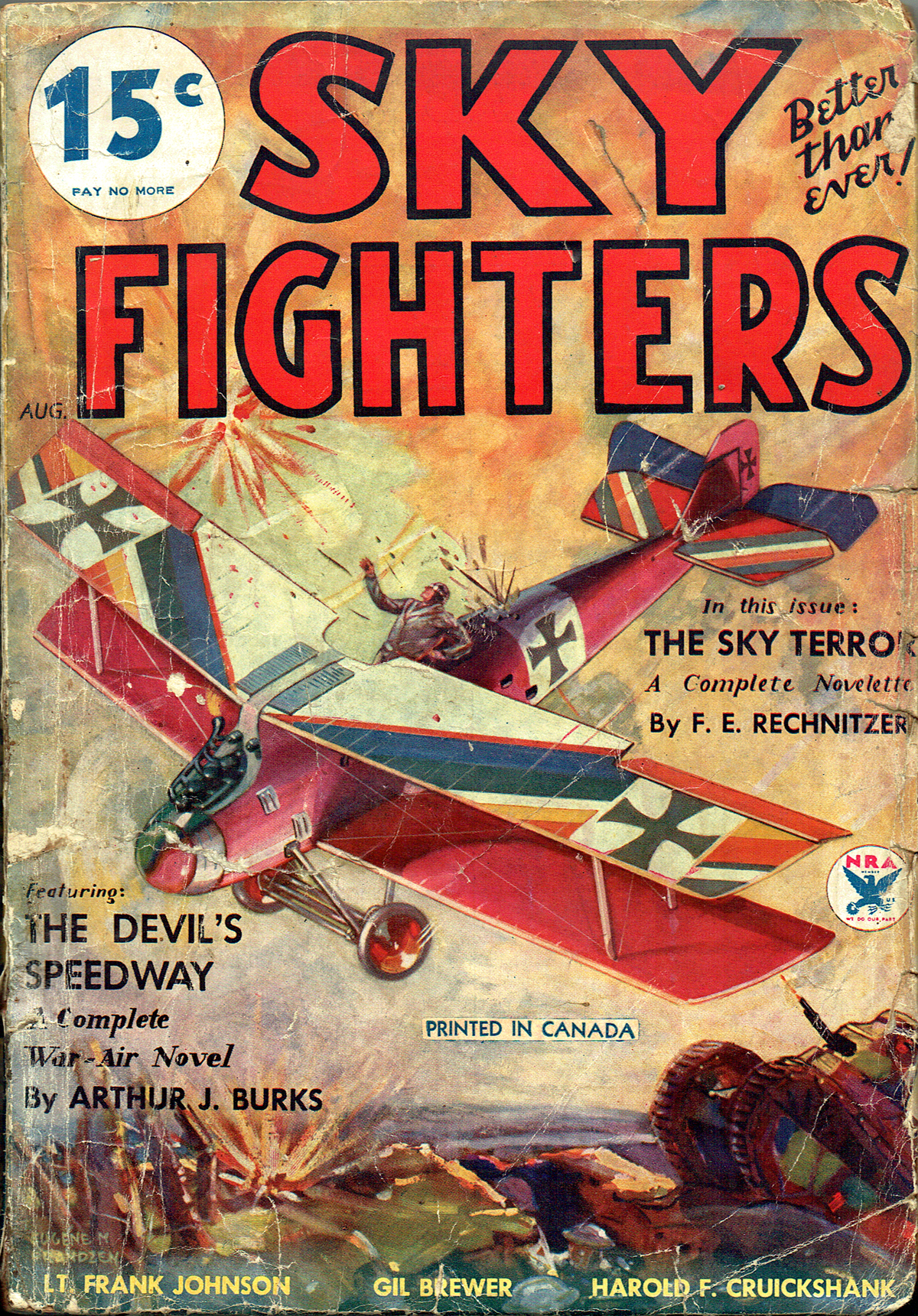“Sky Fighters, August 1934″ by Eugene M. Frandzen
Eugene M. Frandzen painted the covers of Sky Fighters from its first issue in 1932 until he moved on from the pulps in 1939. At this point in the run, the covers were about the planes featured on the cover more than the story depicted. On the August 1934 cover, It’s the Roland D-2 vs a Renault “Chars d’Assaut” baby tank!
The Ships on the Cover
THIS month’s cover  brings us right down to earth. In fact we are dug into a trench with our hob-nailed shoes clawing at the slippery duck boards.
brings us right down to earth. In fact we are dug into a trench with our hob-nailed shoes clawing at the slippery duck boards.
Tin helmets were not much protection for our hard-working doughboys when a raiding German plane came screeching down from the clouds with a couple of synchronized Spandaus tossing hot lead up and down the length of their private trench.

The Roland D-2 with the dazzle painted upper wings was one of Germany’s trickiest looking ships. The peculiarly shaped forward part of the fuselage sweeping up to form a sturdy center brace for the top wings gives the job a certain streamlined effect that is pleasing to the eye. But consider the poor forward visibility of the pilot. He had about as much visibility as a taxi driver with a tin windshield. The two machine-guns are housed in this built-up part of the fuselage, their muzzles barely protruding over the partly hidden Mercedes engine.
A Mere Seven Tons!
The tank in the picture is the famous Renault “Chars d’Assaut.” It was a “Baby tank” weighing a mere seven tons and could crawl along the shell torn fields at from four to six miles an hour (we have baby tanks now which click off ten times this speed).
The first tank was a British invention and first went into action near Cambrai during 1916, smashing the German lines.
From the first the tanks were a success and were made in all conceivable shapes. The outstanding all around success was the baby Renault tank.
The lone Roland D-2 with the swept-back wings has shot down an Allied plane, the only one visible in the sector. Two lines of trenches are just below. Pot-helmeted German troops filled one line of trencher. Flat tin derbies of Americans filled the other. The Roland pilot giggled his head back and forth, tipped his plane down and roared down on the American trenches. His guns blazed and Spandau bullets kicked up mud. Rifles barked back, a ground machine-gun swung up to fire at the attacker, smashed out a spray of lead. Several Yanks went down under the fire, others sought cover. It was a helpless situation.
A ground straffing plane is a dangerous opponent but not as effective as might at first glance be supposed. When it is within range of the trench it is attacking, it lets loose a hail of bullets but it must immediately pull up and dive again to get the correct angle of fire and to keep from crashing.
The Boche Blasts Away
The German pilot leap-frogged his plane up and down the trench, blasting away with both guns. Each time he zoomed, he swept his eyes across all sections of the sky. Still safe from Allied planes he returned to his slaughter.

A small dark shape, so much the color of the ground that it nearly reached the back of the Yank trenches before the German pilot spotted it, crawled slowly forward.
“Verdammte tank!” growled the German and swooped down to show his disdain for this slow-crawling iron beetle. A tattoo of lead spattered the “Baby Renault.” The tank driver stopped his machine. His gunner squinted along the barrel of his 37 millimeter gun. The Roland raced across his sights.
Blam! A 37 millimeter shell smashed through the belly of the plane, tore its way through the German’s body. One well-aimed shell from the lowly mud-spattered iron beetle has clipped the wings of the dazzle-colored Roland.

Sky Fighters (Canadian Edition), August 1934 by Eugene M. Frandzen
(The Ships on The Cover Page)
Next time, Mr. Frandzen features the Pfalz Triplane and the indomitable S.E.5!




